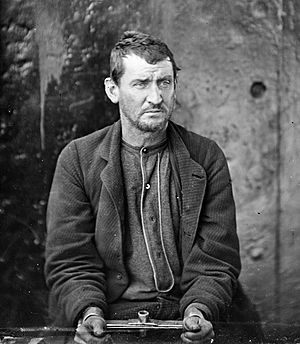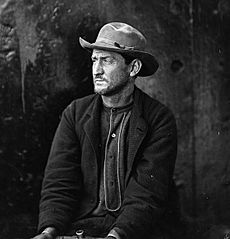Edmund Spangler facts for kids
Quick facts for kids
Edman Spangler
|
|
|---|---|

Edman Spangler, manacled, after his arrest, 1865
|
|
| Born | August 10, 1825 York, Pennsylvania, U.S.
|
| Died | February 7, 1875 (aged 49) Waldorf, Maryland, U.S.
|
| Resting place | Saint Peters Cemetery |
| Nationality | American |
| Other names | Ned Spangler Edward Spangler Edman Spangler |
| Occupation | Carpenter, stagehand |
| Known for | Involvement in the assassination of Abraham Lincoln |
| Criminal status | Pardoned in March 1869 |
| Spouse(s) |
Mary Brasheare
(m. 1858; died 1864) |
| Conviction(s) | Conspiracy |
| Criminal penalty | 6 years imprisonment with hard labor |
| Partner(s) | John Wilkes Booth |
|
Date apprehended
|
April 17, 1865 |
| Imprisoned at | Fort Jefferson, Florida |
Edman "Ned" Spangler (August 10, 1825 – February 7, 1875) was an American carpenter and stagehand. He worked at Ford's Theatre when President Abraham Lincoln was murdered on April 14, 1865. Spangler and seven other people were accused of planning to kill Lincoln and three other important government officials.
Spangler was the only one found not guilty of the main conspiracy charge. However, he was found guilty of helping Lincoln's killer, John Wilkes Booth, escape. He was sentenced to six years of hard labor in prison.
Contents
Early Life and Work
Spangler was born in York, Pennsylvania. His mother died when he was a baby. He was known by several names, including "Ned" to his friends and "Edmund" or "Edward" in family records.
In his early twenties, Spangler became a carpenter. He moved to Maryland and worked with another carpenter, James Johnson Gifford. In the early 1850s, Spangler and Gifford helped build Tudor Hall. This was a summer home for the Booth family. During this time, Spangler met John Wilkes Booth, who was a child then and later became a famous actor.
In 1853, Spangler moved to Baltimore. He worked as an assistant at the Front Street and Holliday Street Theaters. In 1858, Spangler married Mary Brasheare. In 1861, they moved to Washington, D.C.. Spangler started working at Ford's Theatre as a carpenter and scene shifter.
At Ford's Theatre, Spangler met John Wilkes Booth again. By then, Booth was a very popular actor. Spangler admired Booth's fame and was always ready to help him. Spangler, like Booth, did not support ending slavery. He often disagreed with his co-worker Jake Rittersbach, who had fought for the Union Army.
After his wife died in 1864, Spangler faced a difficult time. Friends described him as a kind and friendly person when he was not upset. They also noted his love for jokes, children, and animals.
The Assassination Night
In April 1865, the American Civil War was ending. The Confederate capital, Richmond, fell to Union forces. Soon after, General Lee's army surrendered. These events showed that the war was almost over.
Five days later, on April 14, President Lincoln and his wife Mary went to Ford's Theatre. They were going to watch a play called Our American Cousin. That afternoon, Spangler's boss, Harry Clay Ford, asked him to help get the President's special box ready. Spangler helped move furniture and remove a wall to make two boxes into one large box.
Later, Booth came to the theater. He invited Spangler and other stagehands for a drink. Booth hinted that he might come back for the evening show.
Around 9:30 PM, Booth returned to the theater. He got off his horse in the alley behind Ford's and asked for Spangler. When Spangler came out, Booth asked him to hold his horse. Booth had rented the horse, and the stable owner warned him it was lively and might break its rope if left alone. Spangler said he had work to do. He asked Joseph Burroughs, another theater employee, to hold the horse. Burroughs, known as "Peanut John," agreed. Around 10:15 PM, John Wilkes Booth entered the President's box. He shot Lincoln and quickly escaped from the theater.
Arrest and Trial
Investigators quickly uncovered the plot. It was not just to kill the president, but also Secretary of State William Seward, Vice President Andrew Johnson, and General Ulysses Grant. The Union government believed this was an act of war by the Confederate government. Because it was seen as an act of war, those responsible were tried by a military court, not a regular civilian court.
Spangler was questioned on April 15, 1865, and then released. He was arrested again on April 17. He was accused of helping John Wilkes Booth.
Within a month, eight people, including Spangler, were arrested. They faced a military trial. They were accused of planning to "kill and murder" President Lincoln and the other officials. The charges stated the crime was done "maliciously, unlawfully, and traitorously," to help the rebellion against the United States.
The military trial began on May 9 and ended on June 30. Nine military officers served as both judge and jury.
Spangler was accused of helping Booth get into the President's box. He was also accused of blocking the door outside the box to stop anyone from helping Lincoln. Finally, he was accused of helping Booth escape.
After hearing all the evidence, the officers decided Spangler was not guilty of the main conspiracy charge. He was also found not guilty of helping Booth into the box or blocking the door. However, he was found guilty of helping Booth escape.
Only one witness, Major Joseph B. Stewart, said he saw someone near the escape door. He said the person looked like Spangler. Other witnesses, like Jacob Ritterspaugh, said Spangler was in his usual place backstage after Booth escaped.
Four of the eight people on trial were sentenced to be hanged. These were Mary Surratt, Lewis Powell, David Herold, and George Atzerodt. Dr. Samuel Mudd, Samuel Arnold, and Michael O'Laughlen were sentenced to life in prison. Spangler received a six-year sentence.
Spangler, Dr. Mudd, Samuel Arnold, and Michael O'Laughlen were sent to Fort Jefferson. This prison was in the Dry Tortugas off Key West, Florida. In August 1867, a serious illness called yellow fever spread at the fort. Dr. Mudd tried to treat the sick, and Spangler helped him. Michael O'Laughlen died from yellow fever in September 1867. When Dr. Mudd got sick, Spangler took care of him. Spangler also built coffins for the many prisoners and guards who died from the disease.
Life After Prison
After many requests from Dr. Mudd's wife, Spangler's former boss John T. Ford, and lawyer Thomas Ewing Jr., President Andrew Johnson pardoned Spangler, Dr. Mudd, and Samuel Arnold. This happened on March 1, 1869. They traveled back to Baltimore by boat, arriving on April 6.
After returning home, Spangler worked at the Holliday Street Theatre in Baltimore. This was for his old boss, John T. Ford, who used to own Ford's Theatre. When the Holliday Street Theatre burned down in 1873, Spangler accepted an offer to live at Dr. Mudd's farm in Bryantown, Maryland. The two men had become friends in prison. Dr. and Mrs. Mudd gave him about 5 acres (20,000 m²) of land to farm. Spangler also did carpentry work for people in the area. In his last years, Spangler became a Catholic.
In February 1875, Spangler became ill with a serious lung illness after working in a winter rainstorm. He died on February 7, 1875. He was buried in a graveyard near St. Peter's Church in Charles County, Maryland. A grave marker was placed on his grave in 1983.
Spangler's Statement
After Spangler died, Dr. Samuel Mudd found a handwritten statement in Spangler's toolbox. It was likely written by Spangler while he was in prison. In the statement, Spangler talked about his relationship with John Wilkes Booth. He also said he did not help Booth in any way with the assassination.
Spangler explained that he had known Booth since Booth was a boy. He worked for Booth's father in 1854. Spangler worked as a scene shifter at Ford's Theatre from when it opened until the night Lincoln was shot. He said Booth had free access to the theater and was friendly with everyone. Booth kept his horses in a stable behind the theater. Spangler often looked after Booth's horses when Booth was away.
Spangler also described how Booth asked him to sell a horse, harness, and buggy shortly before the assassination. Spangler tried to sell them at auction but they didn't meet Booth's price. He later sold them for $260.
On the afternoon of April 14, Spangler was told to prepare the President's box. He was helped by Rittespaugh and "Peanut John." Later, Booth asked Spangler to hold his horse. Spangler asked "Peanut John" to do it because he had other duties. Spangler said he was backstage when he heard a shot. He saw a man run across the stage but didn't recognize him as Booth at first. He then heard someone say the President was shot. Spangler helped clear the stage and was very scared. He said he did not see Booth leave through the back door. He also stated he knew nothing about a special hole or bar in the President's box door.
Screen Portrayals
- Murdock MacQuarrie played Edmund Spangler in The Prisoner of Shark Island (1936).
- Tom London played Edmund Spangler in the Wagon Train episode "The John Wilbot Story" (1958).
- Jerry Fleck played Edmund Spangler in The Lincoln Conspiracy (1977).
- Dan DePaola played Edmund Spangler in The Day Lincoln Was Shot (1998).
- James Kirk Sparks played Edmund Spangler in The Conspirator (2010).
- Todd Fletcher played Edmund Spangler in Killing Lincoln (2013).
See also
 In Spanish: Edmund Spangler para niños
In Spanish: Edmund Spangler para niños
- List of people pardoned or granted clemency by the president of the United States


